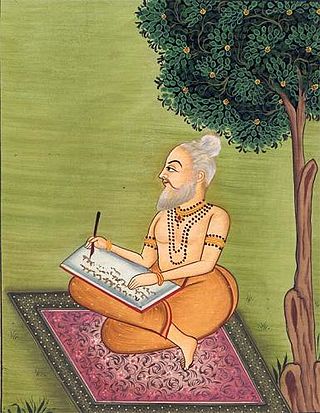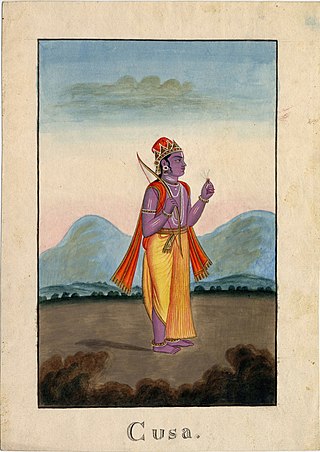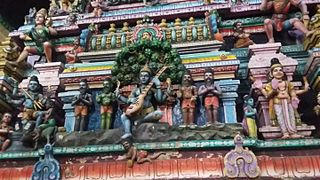
Valmiki was a legendary poet who is celebrated as the traditional author of the epic Ramayana, based on the attribution in the text itself. He is revered as Ādi Kavi, the first poet, author of Ramayana, the first epic poem.

Sugriva, is a character In the ancient Hindu epic Ramayana. He is the younger brother of Vali, whom he succeeded as ruler of the vanara kingdom of Kishkindha. He is a son of Surya, the Hindu deity of the sun. He is the rival of Yak Wat Jaeng, He later married Vali's wife, Tara and adopted their son, Angada. As the king of the vanaras, Sugriva aided Rama in his quest to liberate his wife Sita from captivity at the hands of the rakshasa king Ravana.

Meghanada, also referred to by his epithet Indrajita, according to Hindu texts, was the eldest son of Ravana and the crown prince of Lanka, who conquered Indraloka (Heaven). He is regarded as one of the greatest warriors in Hindu texts. He is a major character mentioned in the Indian epic Ramayana. Meghanada is the central character in Bengali ballad Meghnad Badh Kavya. He played an active role in the great war between Rama and Ravana. He acquired many kinds of celestial weapons from his Guru Shukra. His most prominent feat is having defeated the devas in heaven. Using the Brahmastra, Indrajita killed 670 million vanaras in a single day; nearly exterminating the entirety of the vanara race. No warrior had ever achieved this statistical feat before in the Ramayana. He is the only warrior in the entire Ramayana to defeat both Rama and Lakshmana twice while they were both armed by making them unconscious in a battle with the help of astras and sorcery and finally got killed by Lakshmana. He was said to be more powerful and superior warrior than his father Ravana by Brahma and Agastya.

Koyambedu is a neighbourhood in Chennai, India. Situated in the western part of Chennai city, the Koyambedu area has become a major hub of activity in Chennai after the inauguration of the Koyambedu market in 1996 and the Chennai Mofussil Bus Terminus (CMBT) in 2002. The area is active round the clock owing to the movement of people and goods through the day, with uninterrupted transport facilities such as long-route buses, autos, share autos, vegetable goods carriers and so forth.

Lava and his elder twin brother Kusha, are the children of Rama and Sita in Hindu tradition. Their story is recounted in the Hindu epic, Ramayana and its other versions. He is said to have a whitish golden complexion like their mother, while Kusha had a blackish complexion like their father.

Ramcharitmanas, is an epic poem in the Awadhi language, composed by the 16th-century Indian bhakti poet Tulsidas. It has many inspirations, the primary being the Ramayana of Valmiki.

Avani is a small village in Mulabaagilu taluk, Kolara district in Karnataka, India, about ten miles from Kolar Gold Fields. The village is located at 32 km from Kolara, the district centre and 13 km from Mulabaagilu, the Taluk headquarters. It is a popular location for rock climbing.

Kusha and his younger twin brother Lava were the children of Rama and Sita. Their story is recounted in the Hindu epic, the Ramayana. Hindu traditions claim he ruled the entire region of Kashmir, Indus River and Hindu Kush as frontier lands of India known as Hindu Kush Kshetra and founded the city of Kashmir in the valley and Kasur with Lavapuri of Lava in base lands, though local lore contends Kasur was founded in 1525 by Pashtun migrants. His brother Lava is traditionally believed to have founded Lavapuri.
Vyasarpadi is a neighbourhood of Chennai, India. It is located within Chennai district. The neighbourhood is served by station, one of the oldest stations in South India. The first train to Arcot started from this station. The old ruins still remain 200 metres away from the current station as a cabin room. This place acts as the junction and four rail routes branch from here. The Southern line goes to Chennai Central. The Eastern line goes to Chennai Beach. The Northern line goes to Korukupet further proceeding to Gudur. The Western line goes to Perambur further proceeding to Arakkonam.
Luv Kush is an Indian television series that ran from 1988 to 1989. It was created, written, produced, and directed by Ramanand Sagar. It is a follow-up Ramayan, featuring mostly the same cast and production crew. Luv Kush covers the last book — the Uttarakāṇḍa — of the ancient Indian epic Ramayana, following Rama's coronation, especially focusing on his children, twins Kusha and Lava.
Ayanpuram or Ayanavaram is a neighbourhood in Chennai, India. Konnur High Road, one of the important connecting roads in Chennai runs through Ayanavaram.

Ravishwarar Temple is a Hindu temple in Chennai, India. Built during the Chola period, the temple is dedicated to Shiva. It is located at Murthy Iyengar Street in the northern neighbourhood of Vyasarpadi.

Pariyar, also spelled Pariar, is a village in Sikandarpur Sarausi block of Unnao district, Uttar Pradesh, India. It is located on the left bank of the Ganges, 23 km northwest of the city of Unnao. Nearby the village is the Mahua lake. Pariyar holds religious significance to Hindus; it is considered to be the place where the goddess Sita was exiled to, and the birthplace of her two sons Lava and Kusha. The village is known for holding a major fair during the month of Kartika, on the day of the full moon, which is attended by over 100,000 people. Historically, Pariyar was the seat of a pargana since 1785, and under the Nawabs of Awadh it was the seat of a tehsildar. Today, it is the headquarters of a nyaya panchayat. Pariyar is connected by road with Mohan and Rasulabad. As of 2011, its population is 7,363, in 1,355 households.

Sri Rama Rajyam is a 2011 Indian Telugu-language devotional film directed by Bapu who co-wrote the film with Mullapudi Venkata Ramana, and produced by Yalamanchali Saibabu. The film stars Nandamuri Balakrishna, Nayanthara, Akkineni Nageswara Rao, Srikanth, and its music was composed by Ilaiyaraaja, which won him Nandi Award for Best Music Director. Sri Rama Rajyam is a remake of the 1963 blockbuster film Lava Kusa.

Pallikondeswara Temple(also Pradosha kshetram) is a Hindu temple dedicated to the god Shiva located in Surutupalle, a village in Tirupati district of Andhra Pradesh, India. The presiding deity Pallikondeswara, unlike other Shiva temples, is sported in reclining posture lying on the lap of his consort Parvati.

The Ramalingeshwara group of temples, situated in Avani town of the Kolar district, Karnataka state, India, is constructed in the dravida style. According to the Archaeological Survey of India (ASI), the temple is an ornate 10th-century Nolamba dynasty construction which was partially renovated later by the Chola dynasty.The Vijayanagara kings built the main Mandapam and Rajagopuram. The temple is protected by the Archaeological Survey of India as a monument of national importance.
The SreeSeetha Devi Lava Kusa Temple at Pulpally in Wayanad district has a unique position among the temples of Kerala, and it is also among the rarest temples in India, for it is one of the only known temples to have installed deities of Lava and Kusha, children of Sree Rama and Seetha Devi, with active worship continuing. The legend of Sita, and her children Lava and Kusa is closely linked to this temple. It is believed that even the name Pulpally is connected to the bed of grass (Dharbha) on which Lava is believed to have played as a child.

Kodambakkam is a business and residential neighbourhood in Central Chennai, Tamil Nadu, India. The neighbourhood is served by Kodambakkam railway station of the Chennai Suburban Railway Network. Kodambakkam has a high concentration of film studios and has been known for its status as the hub of the Tamil film industry, lending its name to the industry's monicker Kollywood.

Lav Kush is a 1997 Indian Hindu mythological film, produced by Dilip Kanikaria under the Devyank Arts banner and directed by V. Madhusudhana Rao. It is based on Valmiki's Uttar Ramayan from the Indian epic Ramayana. The music of the film was composed by Raamlaxman. It stars Jeetendra as Rama, Jaya Prada as Sita, Arun Govil as Lakshmana, Dara Singh as Hanuman and Pran as Valmiki.

Lava Temple is a Hindu place of worship dedicated to the Hindu deity Lava, the son of Rama. It is in Lahore Fort, Lahore, Pakistan, and dates to the Sikh period. According to a Hindu legend, Lahore is named after him.
















